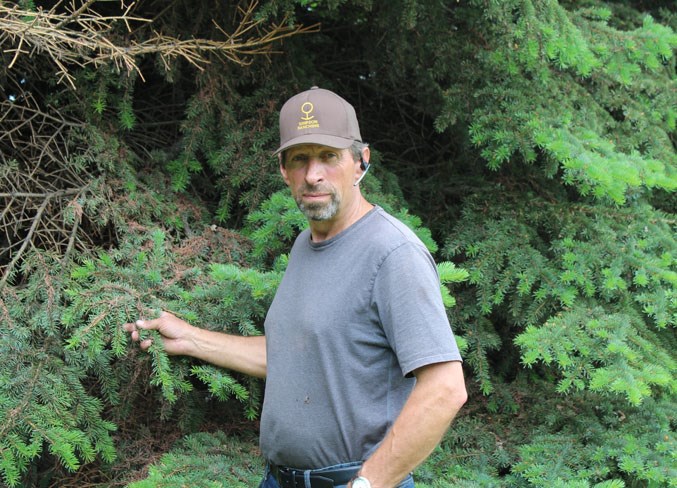DIDSBURY - A local hay farmer from just outside of Didsbury noticed some of his trees were looking bad.
Dwayne Archer of Archer Farms checked with an arborist who said it was likely from road salt.
Unsatisfied with the answer, Archer sent samples from the trees to a specialist with the Alberta Ministry of Agriculture and Forestry.
"We sent samples to the provincial government of different spots in our yard," said Archer. "We met the provincial specialist (Toso Bozic) who instructs all the colleges and municipalities. He ended up having a conference in Airdrie and he came to our farm and spent an hour with us here."
Archer was told that there were different causes for the tree problem.
"Because the trees are so stressed by drought, number 1, we end up with symptoms that cause the needle loss; cause the needles to turn brown," he said. "In some cases we were told the older trees that are stressed too much won't make it.
"The older ones, which we've seen, are rebudding again this year with significant rainfall. Nothing could help more."
Several trees at Archer Farms were also identified as having a fungal disease.
"We treated ours because they identified a fungus called rhizosphaera needlecast," he said. "So we treated our trees a second time hoping that would be beneficial. To be honest, I was just looking for someone to come and say, 'if you do this your problem will go away.' But no one was willing to do that. It just seems to be more complicated."
After the testing was completed, Archer received a letter from Bozic stating three issues with the trees.
"There is a certain amount of sun scald," he said. "The trees were under stress and then we had a long, sunny stretch with -30 last February. Five weeks of it with no chinook weather. They identified that as drying out the needles on the trees."
Another issue identified was that the county is in the third year of a below average moisture cycle.
"We were really looking for a cure to the problem," he said. "We've determined now, because we've been through about three years of drought, the older trees are really suffering for that reason first. The harshness of last February with the coldness and no chinooks certainly browned off a bunch of needles. And then when the trees are under stress they pick up a disease called rhizosphaera needlecast, which is a symptom of the above."
Bozic, a crop assurance extension specialist with Alberta Agriculture and Forestry, said in an email to Archer that the trees at his farm, many of which are 60-70 years old, can live up to 140 years.
"Besides insects, diseases or environmental issues -- tree competition for water, minerals and nutrients can create mortality among trees," wrote Bozic in an email. "If you have high density of trees in your shelterbelts, the weak and dying ones need to be removed to let the others spread and grow. Make sure that removing weak ones will not undermine shelterbelt integrity and functionality."
Archer first noticed the spruce trees looking rough a couple of years ago.
"It started showing up more and more," he said.
Archer has about 1,000 trees on his property. He has also heard similar complaints about other people's trees.
"Any situation in which you would put a tree under stress is where it shows up most," he said. "Your trees could be stressed if they're too close together or there's less moisture."
Archer said that they will be working on preventive maintenance moving forward.
"We're going to set ourselves up to water on a regular basis when we don't have enough rain," he said. "We want to try and get the trees healthier. We've sprayed twice with a fungicide to try and curb the rhizosphaera needlecast."
Archer said they've lost some trees but he's optimistic they will be able to save many more by watering regularly, having less confined spaces, and by applying fungicide.
"Most rural people really covet their trees as far as shelter and windbreak goes as well as aesthetics," he said.



